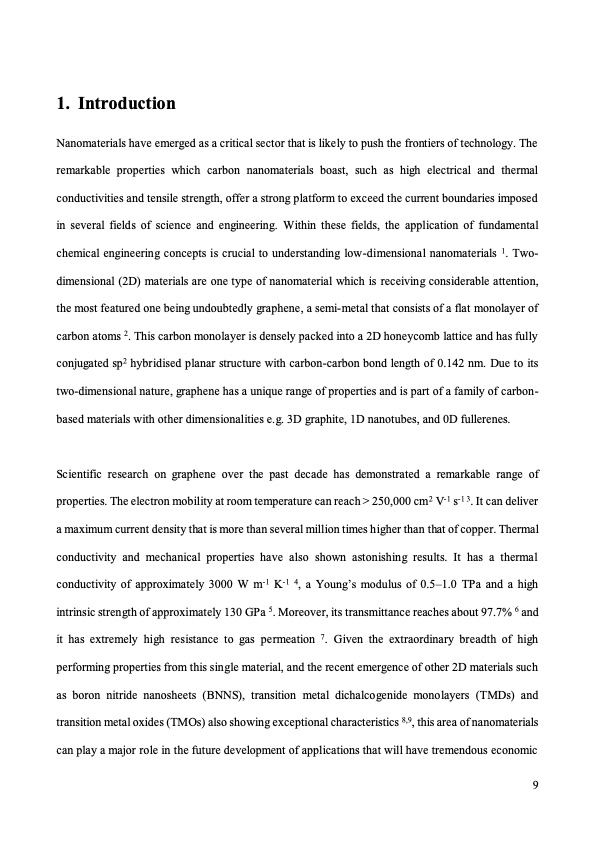
PDF Publication Title:
Text from PDF Page: 009
1. Introduction Nanomaterials have emerged as a critical sector that is likely to push the frontiers of technology. The remarkable properties which carbon nanomaterials boast, such as high electrical and thermal conductivities and tensile strength, offer a strong platform to exceed the current boundaries imposed in several fields of science and engineering. Within these fields, the application of fundamental chemical engineering concepts is crucial to understanding low-dimensional nanomaterials 1. Two- dimensional (2D) materials are one type of nanomaterial which is receiving considerable attention, the most featured one being undoubtedly graphene, a semi-metal that consists of a flat monolayer of carbon atoms 2. This carbon monolayer is densely packed into a 2D honeycomb lattice and has fully conjugated sp2 hybridised planar structure with carbon-carbon bond length of 0.142 nm. Due to its two-dimensional nature, graphene has a unique range of properties and is part of a family of carbon- based materials with other dimensionalities e.g. 3D graphite, 1D nanotubes, and 0D fullerenes. Scientific research on graphene over the past decade has demonstrated a remarkable range of properties. The electron mobility at room temperature can reach > 250,000 cm2 V-1 s-1 3. It can deliver a maximum current density that is more than several million times higher than that of copper. Thermal conductivity and mechanical properties have also shown astonishing results. It has a thermal conductivity of approximately 3000 W m-1 K-1 4, a Young’s modulus of 0.5–1.0 TPa and a high intrinsic strength of approximately 130 GPa 5. Moreover, its transmittance reaches about 97.7% 6 and it has extremely high resistance to gas permeation 7. Given the extraordinary breadth of high performing properties from this single material, and the recent emergence of other 2D materials such as boron nitride nanosheets (BNNS), transition metal dichalcogenide monolayers (TMDs) and transition metal oxides (TMOs) also showing exceptional characteristics 8,9, this area of nanomaterials can play a major role in the future development of applications that will have tremendous economic 9PDF Image | graphene production via nonoxidizing liquid exfoliation

PDF Search Title:
graphene production via nonoxidizing liquid exfoliationOriginal File Name Searched:
Graphene-R2-review.pdfDIY PDF Search: Google It | Yahoo | Bing
Salgenx Redox Flow Battery Technology: Power up your energy storage game with Salgenx Salt Water Battery. With its advanced technology, the flow battery provides reliable, scalable, and sustainable energy storage for utility-scale projects. Upgrade to a Salgenx flow battery today and take control of your energy future.
| CONTACT TEL: 608-238-6001 Email: greg@infinityturbine.com | RSS | AMP |